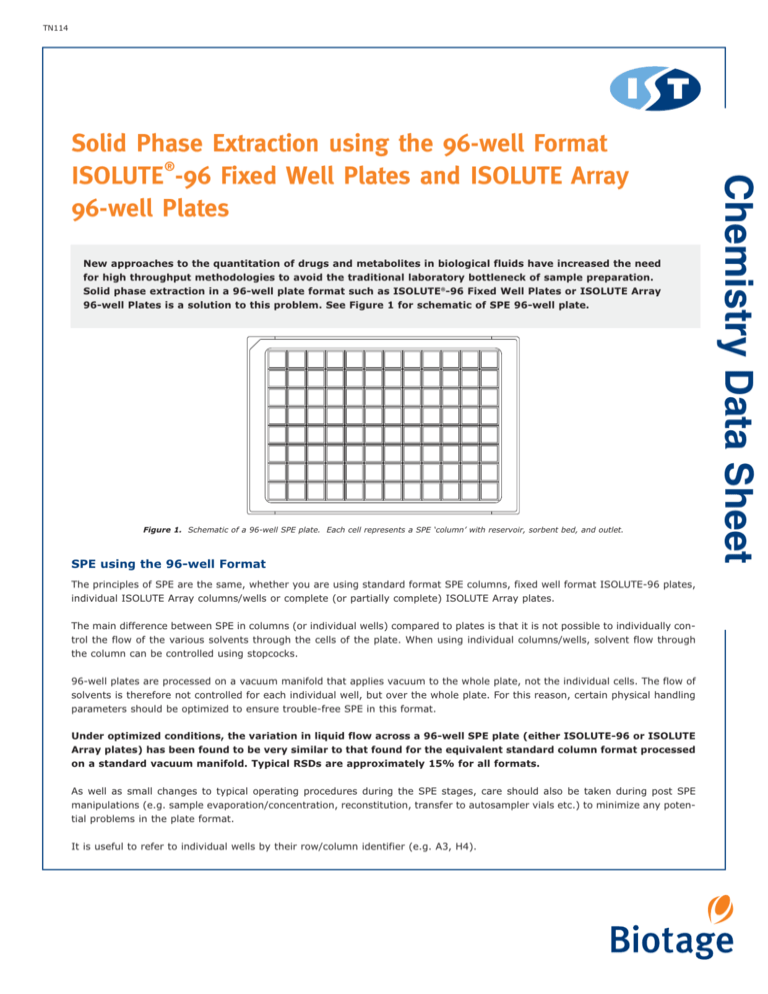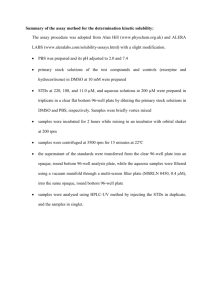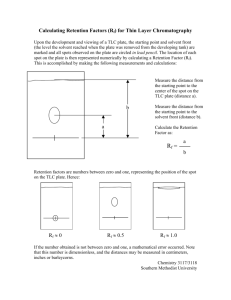
TN114
New approaches to the quantitation of drugs and metabolites in biological fluids have increased the need
for high throughput methodologies to avoid the traditional laboratory bottleneck of sample preparation.
Solid phase extraction in a 96-well plate format such as ISOLUTE®-96 Fixed Well Plates or ISOLUTE Array
96-well Plates is a solution to this problem. See Figure 1 for schematic of SPE 96-well plate.
Figure 1. Schematic of a 96-well SPE plate. Each cell represents a SPE ‘column’ with reservoir, sorbent bed, and outlet.
SPE using the 96-well Format
The principles of SPE are the same, whether you are using standard format SPE columns, fixed well format ISOLUTE-96 plates,
individual ISOLUTE Array columns/wells or complete (or partially complete) ISOLUTE Array plates.
The main difference between SPE in columns (or individual wells) compared to plates is that it is not possible to individually control the flow of the various solvents through the cells of the plate. When using individual columns/wells, solvent flow through
the column can be controlled using stopcocks.
96-well plates are processed on a vacuum manifold that applies vacuum to the whole plate, not the individual cells. The flow of
solvents is therefore not controlled for each individual well, but over the whole plate. For this reason, certain physical handling
parameters should be optimized to ensure trouble-free SPE in this format.
Under optimized conditions, the variation in liquid flow across a 96-well SPE plate (either ISOLUTE-96 or ISOLUTE
Array plates) has been found to be very similar to that found for the equivalent standard column format processed
on a standard vacuum manifold. Typical RSDs are approximately 15% for all formats.
As well as small changes to typical operating procedures during the SPE stages, care should also be taken during post SPE
manipulations (e.g. sample evaporation/concentration, reconstitution, transfer to autosampler vials etc.) to minimize any potential problems in the plate format.
It is useful to refer to individual wells by their row/column identifier (e.g. A3, H4).
Chemistry Data Sheet
Solid Phase Extraction using the 96-well Format
®
ISOLUTE -96 Fixed Well Plates and ISOLUTE Array
96-well Plates
Sample Processing/liquid Handling
The speed of manually dispensing the conditioning solvent, equilibration solvent, sample, interference elution solvents and
analyte elution solvent using the 96-well format can be greatly enhanced using a standard multi-port (8 or 12 position)
dispenser. Solvent is dispensed simultaneously into every well of a column (i.e. A1 to H1) or row on the plate.
There are also a number of automated liquid handling systems available which are suitable for SPE use.
The Different 96-well SPE Plate Formats Available
ISOLUTE-96 Fixed Well Plates
ISOLUTE-96 fixed-well plates consist of 96 (8 x 12 matrix) fixed position wells packed with SPE sorbent – the industry
standard format. The nominal volume of each well is approximately 1.2 mL, and sorbent bed masses typically range from
25–100 mg per well (10 mg for resin based sorbents).
ISOLUTE Array 96-well Plates
ISOLUTE Array 96-well Plates and SPE columns have been designed for scientists who require a versatile SPE format that is
compatible with both high and low sample throughput.
The ISOLUTE Array system consists of individual SPE columns (1 or 2 mL volume, typically 10–100 mg sorbent bed mass)
that can be processed using a traditional vacuum manifold (e.g. VacMasterTM-10 or -20 Sample Processing Manifolds) in
exactly the same way as standard 1 mL ISOLUTE SPE Columns.
Alternatively the individual ISOLUTE Array columns can be fitted into a 96 position (8 x 12) base plate for processing as a
standard 96-well SPE plate using a plate format vacuum manifold (e.g. VacMaster-96 Sample Processing Manifold). The plate
assembly can be complete (8 x 12 wells in place) or partially complete (any number of columns up to 96 in place). If using a
partially complete ISOLUTE Array plate, the empty positions must be blocked off using base plate plugs.
Populating the Array Base Plate
Populate the ISOLUTE Array base plate with Array columns of the chosen configuration as follows:
Place the base plate on the VacMaster-96 manifold lid.
Fill positions A1 up to A12 as required, ensuring the columns are aligned correctly using the well alignment/removal tool,
and press firmly into place.
Fill positions B1 to H1 ensuring the columns are aligned correctly, and press firmly into place.
Using the filled positions as a guide, place the remaining columns in position until the desired number of wells are filled.
Using the leveling tool, press the columns firmly into place.
Seal any remaining empty positions with strips of 8 base plate plugs.
The ISOLUTE Array plate is now ready for use.
Processing the 96-well SPE Plates
The VacMaster-96 manifold is designed for processing both the ISOLUTE-96 and ISOLUTE Array plate formats.
2
Six-step SPE
The most commonly used mode of solid phase extraction in bio-analytical applications is ‘six-step SPE’. It can produce extracts
of biological fluids (plasma, serum, urine) having high purity, and concentrated analytes (drugs and/or metabolites). This mode
involves 6 steps as follows:
Sample pre-treatment
Solvation (conditioning)
Equilibration
Sample loading
Interference elution
Analyte elution
(A brief description of each of these steps is given below. Please request Chemistry Data Sheet TN110 for a full description of
each of these steps, and other modes of operation of SPE). Chemistry Data Sheets describing the use of specific ISOLUTE
sorbents are also available.
Sample Pre-treatment
See relevant Chemistry Data Sheets for specific sorbents. As stated previously the chemistry of SPE remains the same for 96well format.
Dilution Factors
As biological fluids (particularly plasma or serum samples) can vary significantly in their viscosity from sample to
sample, it is important to use dilution to lower and standardize the viscosity of the samples, to ensure even,
reproducible flow from well to well, and minimize well blockage. In general, the greater the dilution factor, the
more even the results.
In order to maintain the control of both chemical and physical parameters, dilution with a suitable BUFFER is
recommended. See Figure 2 for the effect of dilution on flow rate. As plasma varies in viscosity, this is a guideline
to dilution only.
Buffer
1:9
1:5
1:2
1:1
Undiluted Plasma
NO FLOW
0
10
20
30
40
50
Relative flow rates (µL/min)
Figure 2. Flow rates of 250 µL of undiluted plasma, and plasma diluted with buffer, using 25 mg ISOLUTE Array plate
3
Solvation
Solvation is usually necessary to prepare the sorbent for the extraction process. For certain sorbents the sorbent bed should
not be allowed to dry out after solvation.
It is recommended that wells are initially conditioned with an excess of methanol (or other suitable solvent) loaded under
gravity or low vacuum (-2 "Hg). This has the effect of making the flow of subsequent solvent/sample loading steps more even
across the plate.
Typical Volumes
Bed Mass
Solvation Volume
10 mg
220 µL
25 mg
500 µL
100 mg
2 mL
It has been noted that if the top frit is allowed to become dry (i.e. the level of solvation solvent drops below the surface of
the frit material), it can be difficult to induce the flow of the next aqueous step using a low vacuum. This is due to the
hydrophobic nature of the frit material, and is not related to the sorbent type (applies equally to silica based and
resin based sorbents). The following procedures apply to each subsequent aqueous step of the method.
There are various procedures that can help minimize this. Processing regimes differ slightly between low bed mass (10 and 25
mg) and higher bed mass (50 and 100 mg) plates.
Processing Procedures
10 mg
In general, all steps can be loaded under gravity. Under these conditions, frits
are unlikely to dry out, and flows of subsequent steps will be unaffected.
25 mg
In general, all steps can be loaded under gravity, although some variation in flow
may occur under these conditions. If necessary, a low vacuum (–2 "Hg) is ample
to give a good flow rate and is not high enough to dry the frits.
50 and 100 mg
For best results, approximately 5% methanol should be added to all subsequent
aqueous steps (provided this does not affect analyte recovery). All wells should
be loaded with no vacuum, and a pulse of high vacuum (–10 "Hg, 2 seconds)
applied to initiate flow. The vacuum should then be reduced to –2 "Hg.
In general we recommend that as long as sufficient capacity is obtained from a 10 or 25 mg bed mass, that
this configuration be the bed mass of choice for 96-well plate based SPE methods.
If the subsequent step has a high % organic component, the hydrophobicity of the frit will be overcome by the solvent,
and flow should occur without problems.
For ISOLUTE Array plates, it is possible to optimize vacuum levels on individual wells on a standard vacuum manifold (eg
VacMaster-10 or -20 manifold),
and transfer directly to the plate for increased throughput.
4
Equilibration
To maximize retention of the analyte by the sorbent, the column is treated with a solvent that is as ‘matrix-like’ as possible.
A typical volume of equilibration solvent is 0.2–1 mL/50 mg of sorbent.
Sample Loading
Load the diluted sample as follows:10 mg
Load under gravity
25 mg
Load under gravity, OR apply a low vacuum of –2" Hg, either during or
after sample application
50 and 100 mg plate
Apply a low vacuum of –2" Hg, either during or after sample application,
OR load sample into all wells with no vacuum, followed by a pulse of –5
to –10 "Hg, reduced to –2" Hg after 2 seconds
Interference Elution
The purpose of interference elution is to selectively remove undesired compounds from the sorbent without eluting the
analytes. A typical volume of interference elution solvent is 0.2–1 mL /50 mg of sorbent. Interference elution should be
carried out under minimum vacuum.
Sorbent drying may be necessary to remove excess solvent prior to elution. In the plate format, it is not easy
to visually judge whether an individual well is dry. Any drying regime therefore should be clearly specified in
terms of drying time and vacuum required.
A typical drying time for subsequent elution with water miscible solvents is about 30 seconds per 10 mg
sorbent at -10 "Hg. If a water immiscible solvent is used for elution, drying times would be significantly
longer. We recommend that the optimum conditions be determined experimentally for individual applications.
Elution
Prior to elution, ensure that the collection plate has been inserted into the VacMaster-96 manifold, in the
correct alignment (i.e. position A1 on the extraction plate is aligned directly above position A1 on collection
plate). This will ensure that individual samples are not confused.
Replace the polypropylene lid of the VacMaster-96 manifold and ISOLUTE-96 or ISOLUTE Array plates. Ensure that the
extraction plate outlets are correctly positioned, and inserted into the collection plate wells. Spacers are available to raise
collection plates, and ensure penetration. This is important to prevent cross contamination between wells.
Apply the elution solvent and allow to flow under suitable vacuum conditions as appropriate to bed mass. For all bed
masses, a pulse of vacuum at the end of elution will ensure that all elution solvent is collected.
Minimum elution volumes as low as 100 µL for 25 mg sorbent mass may be achieved with robust/optimized SPE methods.
Flow control is important to ensure reproducibility.
5
Post SPE Sample Manipulation
When using either ISOLUTE-96 or ISOLUTE Array plates, the analytes are eluted into a collection plate (consisting of an 8 x
12 matrix of collection wells). These plates are available in 1 and 2 mL volumes as standard. The collection plate can be
sealed for storage purposes if analysis is not to be performed immediately.
Direct Injection
To minimize sample manipulation following SPE, analytes should be eluted using a solvent system that is directly compatible
with the analytical technique. If the elution solvent is too strong for compatibility with the analytical technique, and further
concentration is not required, the eluent should be diluted with mobile phase buffer.
The collection plate can then be placed directly onto a 96-position autosampler.
Eluent Evaporation/Concentration
Depending on the analytical technique/methodology to be used to analyze the extracted samples, it may be necessary to
further concentrate, or evaporate and reconstitute the eluent, prior to the analytical stage.
Using a 96-well sample concentrator (e.g. SPE DryTM 96), this step can be performed in the collection plate. In
the plate format, it is not easy to visually judge whether an individual well is dry, or what volume of solvent
remains. Any drying regime therefore should be clearly specified in terms of instrument, temperature, drying
time and gas type and flow rate.
See page 7 for solvent evaporation times using the SPE Dry 96 system.
6
SPE Dry 96 solvent evaporation times
Solvent
* 500 µL/40 ˚C
** 1 mL/40 ˚C
500 µL/60 ˚C
** 1 mL/40 ˚C
Water
90
165
46
86
Methanol
14
28
11
20
Methanol/Water 50/50 (v/v)
46
95
28
56
16.5
26
11.5
16.5
Acetonitrile/Water 50/50 (v/v)
51
60
31
36
Methanol/Acetonitrile 50/50 (v/v)
19
24
12
15
Acetonitrile
17
20
12
15.5
Methanol/1% (v/v) NH4OH
18
28
13.5
16
DMF
73
105
33
41
Methanol/Methylene Chloride 50/50 (v/v)
12
15.5
7.5
9.5
Methylene Chloride/1% (v/v) NH4OH
8.5
11.5
6
8
Propan-2-ol
* 500 µL volumes were in a 1 mL collection plate
** 1 mL volumes were in a 2 mL collection plate
1. Experiments were conducted with flow rate at 50 L/min at the upper manifold and 30 L/min at the lower manifold.
2. Drying gas used was compressed air. Only standard moisture trap was used within the system. Moisture content
of ambient air will affect results.
3. All temperatures listed in above table refer to the top head. Bottom unit was 20 °C higher.
Typical evaporation times (minutes) for commonly used solvents. Forced gas convection heating from above and
below each microplate well evaporates solvents up to five times more rapidly than other microplate sample
evaporation systems.
www.biotage.com
UNITED STATES AND CANADA
Main Office: +1 434 979 2319
Toll Free: +1 800 446 4752
Fax: +1 434 979 4743
Order Tel: +1 434 220 2687
Order Fax: +1 434 296 8217
ordermailbox@biotage.com
UNITED KINGDOM
Main Office: +44 1443 811811
Fax: +44 1443 816552
Order Tel: +44 1443 811822
Order Fax: +44 1443 816816
eurosales@eu.biotage.com
SWEDEN
Main Office: +46 18 56 5900
Fax: +46 18 59 1922
Order Tel: +46 18 56 57 10
Order Fax: +46 18 56 57 05
order@eu.biotage.com
GERMANY
Tel: +49 7624 90 80 0
Fax: +49 7624 90 80 10
separtis@eu.biotage.com
SWITZERLAND
Tel: +41 61 743 90 15
Fax: +41 61 743 90 18
separtis@eu.biotage.com
AUSTRIA
Tel: +43 2231 63167
Fax: +43 2231 63520
separtis@eu.biotage.com
JAPAN
Tel: +81 422 28 1233
Fax: +81 422 28 1236
order@biotage.co.jp
Copyright © 2006. All rights reserved. All brand and product names are trademarks or registered trademarks of
their respective companies. The information contained in this document is subject to change without notice.
TN-114.06







